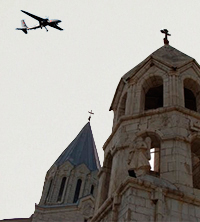
The Soviet Union carried out various ideological propaganda through the churches. One such important function during the Cold War was the struggle for peace. It should be noted, however, that in addition to this external coercion, Christianity seeks to give man inner peace, which is inseparable from the desire to live in peace with other people.
The Cold War was not only a struggle between the West and the Soviet Union, but also between atheism and the principles of freedom of conscience. This was the reason why the clergy were constrained to join the struggle for peace imposed by the state, because the Cold War was also a struggle between the “atheism” of communist materialism.
Finnish culturologist P. Kuusi insisted that man could take the most cruel step (kill members of his kind) only by “believing in the permission and blessing of the higher powers.” Therefore, for man, “God was first and foremost needed for war. “Only the belief in ‘forgiveness’ and ‘salvation of the world’ could justify war as the worst evil of mankind.”
For Christian churches, issues of peace and war are elaborated in more detail in Catholic theology. Theology of peace even has a special name – irinology. The Catholic Church sees the cause of war and other evils in man’s sinful nature.
Paul VI was the first Christian leader to call on all nations and states to “build international peace” from the rostrum of the United Nations and to declare January 1 of each year a World Day of Peace.
Pope John Paul II declared his commitment to peace. John Paul II in his “Atonement of Man” encyclical divided the idea of peace into two parts: “Philosophy of Peace” and “Theology of Peace”.
At the same time, he stressed that everyone is developing a “philosophy of peace”, but the results of achieving real peace are very modest. But the “theology of peace” has not yet become widespread, yet that is what should ensure lasting peace on Earth.
In general, his idea of peace is based on the implementation of four basic principles: justice, truth, freedom and love. Peace, according to the Pope, will come “only when these principles are transferred from the sphere of desires to the sphere of people’s beliefs.” Thus, John Paul II conditioned peacekeeping on “man’s understanding of the Bible.”
The idea of peacekeeping was formed in Protestantism in the mid-1980s, and in the late 1990s, in order to maintain their influence, Protestant ideologues began to develop and apply the concept of a culture of peace.
In the most general sense, this concept was expressed as follows: Refusing to understand war as an “inevitable evil,” “God does not want war,” and we must fight it.
Maintaining the supremacy of religion in promoting peace, Protestant theologians emphasize the need for cooperation with non-religious political movements in the struggle for peace, and so on. The Second Artsakh War made the Armenian Apostolic Church to specify its position not only in theory.
Before the war, one of the official statements says: His Holiness affirmed that from the very first day of the Karabakh conflict, the Mother See, with its dioceses and communities around the world, supported the Armenians of Artsakh by all possible means to prevent the patriarchs from religiously coloring the conflict, to help reduce border tensions, the return of captives, and the peaceful settlement of the conflict. (1)
During the war, the church made patriotic appeals. For example, it was associated with mystical symbols.(2)
Many churches responded to the Second Artsakh War. The reaction of the Georgian Patriarch Ilia II should be considered important. The message says: “We were alarmed by the beginning of confrontation. It is especially painful for us, because we are neighbors and friends, many Azeris and Armenians live in Georgia.” “We pray that God will send peace to Armenia, Azerbaijan and the whole Caucasus,” the statement said. (3)
On the very first day of the war, Catholicos Garegin II addressed Pope Francis. Pope Francis expressed his concern on September 27. “We are receiving alarming news from the Caucasus. “I pray for peace in this region; I call on the parties to the conflict to take clear steps for the sake of brotherhood, to resolve all issues without the use of force.” (4) Russian Patriarch Kirill II reacted similarly. On October 13, he called for a ceasefire (5) and etc.
Two of the Pope’s other statements also should be mentioned. Pope Francis considers Karabakh war a tragedy and mentions that innocent people fall victim. (6) In his Christmas sermon, he called for maintaining the ceasefire in Artsakh. (7)
Religion can play a big role in solving social and political problems, but the issues of war and peace are solved by politicians, but such appeals of the clergy are importan, especially for their followers.
(1) https://iravunk.com/?p=182064&l=am
(2) https://www.pastinfo.am/hy/news/2020/09/30/Պատահական-չէ-որ-Արցախի-նկատմամբ-թշնամու-սադրիչ-հարձակումը-տեղի-ունեցավ-Վարագա-Սուրբ-խաչի-տոնի-կիրակի-օրը-Հաղթելու-ենք-Տեր-Սմբատ-քահանա-Սարգսյան/1065143
(3 ) https://armeniasputnik.am/armenia/20200928/24635745/sa-mez-hamar-arandznaki-tsavot-e-vrastani-patriarq-ilya-erkrord-dimel-e-yerevanin-u-baqvin.html
(4) https://regnum.ru/news/3074717.html
(5) https://ria.ru/20201013/rezhim-prekrascheniya-ognya-1579532768.html
(6) https://arminfo.info/full_news.php?id=57505&lang=2
(7) https://www.rfi.fr/ru/в-мире/20201225-папа-франциск-призвал-к-соблюдению-перемирия-в-карабахе-и-на-востоке-украины